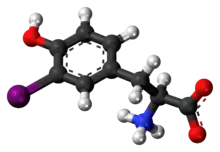3-Iodotyrosine
 | |
 3-Iodo-L-tyrosine | |
| Names | |
|---|---|
| IUPAC name
(2S)-2-Amino-3-(4-hydroxy-3-iodophenyl)propanoic acid | |
| Other names
Monoiodotyrosine; MIT[1] | |
| Identifiers | |
CAS Number |
|
3D model (JSmol) |
|
| ChEMBL | |
| ChemSpider | |
| DrugBank | |
| ECHA InfoCard | 100.000.677 |
| MeSH | Monoiodotyrosine |
PubChem CID |
|
CompTox Dashboard (EPA) |
|
InChI
| |
SMILES
| |
| Properties | |
Chemical formula |
C9H10INO3 |
| Molar mass | 307.087 g·mol−1 |
Except where otherwise noted, data are given for materials in their standard state (at 25 °C [77 °F], 100 kPa). | |
| Infobox references | |
3-Iodotyrosine is an intermediate in the synthesis of thyroid hormones which is derived from iodination of tyrosine at the meta-position of the benzene ring. One unit can combine with diiodotyrosine to form triiodothyronine, as occurs in the colloid of the thyroid follicle. Two units can combine to form 3,3'-diiodothyronine.
3-Iodotyrosine is a reversible inhibitor of the enzyme tyrosine hydroxylase.[2]
Relevance in dopamine studies
3-Iodotyrosine, a pathway inhibitor in the synthesis of the neurotransmitter dopamine, was used to determine the effects of decreased dopamine levels in social spacing of Drosophila melanogaster. 3-4 day old flies that were fed 3-iodotyrosine for 24 hours were shown to have altered dopamine levels.[3]
References
- ↑ Tietze F, Kohn LD, Kohn AD, et al. (March 1989). "Carrier-mediated transport of monoiodotyrosine out of thyroid cell lysosomes". J. Biol. Chem. 264 (9): 4762–5. doi:10.1016/S0021-9258(18)83654-7. PMID 2925666.
- ↑ Richelson E (November 1976). "Properties of tyrosine hydroxylation in living mouse neuroblastoma clone N1E-115". Journal of Neurochemistry. 27 (5): 1113–8. doi:10.1111/j.1471-4159.1976.tb00317.x. PMID 12170597. S2CID 24808699.
- ↑ Fernandez, Robert W.; Akinleye, Adesanya A.; Nurilov, Marat; Feliciano, Omar; Lollar, Matthew; Aijuri, Rami R.; O'Donnell, Janis M.; Simon, Anne F. (2017-08-01). "Modulation of social space by dopamine in Drosophila melanogaster, but no effect on the avoidance of the Drosophila stress odorant". Biology Letters. 13 (8): 20170369. doi:10.1098/rsbl.2017.0369. ISSN 1744-9561. PMC 5582115. PMID 28794277.
This article is issued from Offline. The text is licensed under Creative Commons - Attribution - Sharealike. Additional terms may apply for the media files.